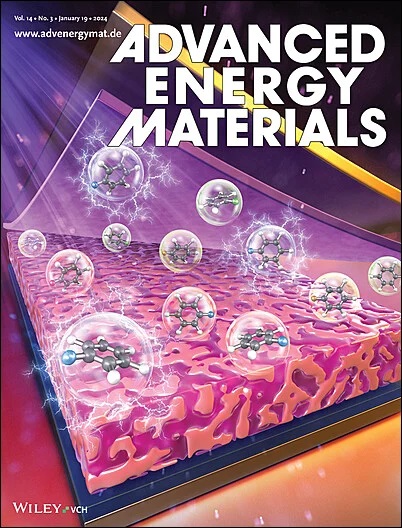Programmable Solid Electrolyte Interphase Enables Simultaneous Optimization of Electrochemical Performance and Self-Discharge of Lithium Sulfur Batteries under Practical Conditions
IF 24.4
1区 材料科学
Q1 CHEMISTRY, PHYSICAL
引用次数: 0
Abstract
The development of lithium–sulfur batteries is impeded by their suboptimal electrochemical performance and significant self-discharge under practical conditions, especially at high sulfur-to-host ratios and low electrolyte-to-sulfur ratios. Under these conditions, improving electrochemical performance necessitates accelerating the polysulfides conversion, while reducing self-discharge entails inhibiting the same conversion (disproportionation reaction, a key contributor to self-discharge). Herein, to address this challenging contradiction, an imprisoning strategy is designed that utilizes programmable solid electrolyte interphase (SEI) layers formed only on the outer surface of TiO2−x coated hollow carbon spheres (TiO2−x@C). TiO2−x@C is chosen primarily because that it supports regulated SEI growth upon simple voltage control, leveraging the different SEI formation potential on TiO2−x and C, and its conductivity and catalytic property ensure high sulfur reaction kinetics. This strategy functions effectively even under practical conditions. The exposed internal surface provides abundant effective sites and the outer SEI (as a dense barrier) prevents polysulfides from migrating out of spheres, improving the electrochemical performance. These soluble polysulfides, being confined within spheres, easily reach saturation concentrations during storage, inhibiting disproportionation reaction. Consequently, SEI wrapped TiO2−x@C/sulfur cathodes exhibit both high electrochemical performance and low self-discharge. This work is a new attempt to achieve above simultaneous optimization without performance compromise.

可编程固体电解质界面使锂硫电池在实际条件下的电化学性能和自放电同时优化
锂硫电池在实际条件下,尤其是在高硫与母体比率和低电解质与硫比率的情况下,电化学性能不理想,自放电严重,这阻碍了锂硫电池的发展。在这些条件下,要提高电化学性能,就必须加速多硫化物的转化,而要减少自放电,就必须抑制相同的转化(歧化反应,自放电的关键因素)。为了解决这一具有挑战性的矛盾,本文设计了一种囚禁策略,利用仅在涂有 TiO2-x 的空心碳球(TiO2-x@C)外表面形成的可编程固体电解质相(SEI)层。之所以选择 TiO2-x@C,主要是因为它可以利用 TiO2-x 和 C 上不同的 SEI 形成电位,在简单的电压控制下支持可调节的 SEI 生长,而且它的导电性和催化特性确保了高硫反应动力学。这种策略即使在实际条件下也能有效发挥作用。裸露的内表面提供了丰富的有效位点,外层 SEI(作为致密屏障)可防止多硫化物迁移出球体,从而改善电化学性能。这些可溶性多硫化物被限制在球体内,在储存期间很容易达到饱和浓度,从而抑制歧化反应。因此,SEI包裹的TiO2-x@C/硫阴极既具有较高的电化学性能,又具有较低的自放电。这项工作是在不影响性能的前提下实现上述同步优化的新尝试。
本文章由计算机程序翻译,如有差异,请以英文原文为准。
求助全文
约1分钟内获得全文
求助全文
来源期刊

Advanced Energy Materials
CHEMISTRY, PHYSICAL-ENERGY & FUELS
CiteScore
41.90
自引率
4.00%
发文量
889
审稿时长
1.4 months
期刊介绍:
Established in 2011, Advanced Energy Materials is an international, interdisciplinary, English-language journal that focuses on materials used in energy harvesting, conversion, and storage. It is regarded as a top-quality journal alongside Advanced Materials, Advanced Functional Materials, and Small.
With a 2022 Impact Factor of 27.8, Advanced Energy Materials is considered a prime source for the best energy-related research. The journal covers a wide range of topics in energy-related research, including organic and inorganic photovoltaics, batteries and supercapacitors, fuel cells, hydrogen generation and storage, thermoelectrics, water splitting and photocatalysis, solar fuels and thermosolar power, magnetocalorics, and piezoelectronics.
The readership of Advanced Energy Materials includes materials scientists, chemists, physicists, and engineers in both academia and industry. The journal is indexed in various databases and collections, such as Advanced Technologies & Aerospace Database, FIZ Karlsruhe, INSPEC (IET), Science Citation Index Expanded, Technology Collection, and Web of Science, among others.
 求助内容:
求助内容: 应助结果提醒方式:
应助结果提醒方式:


